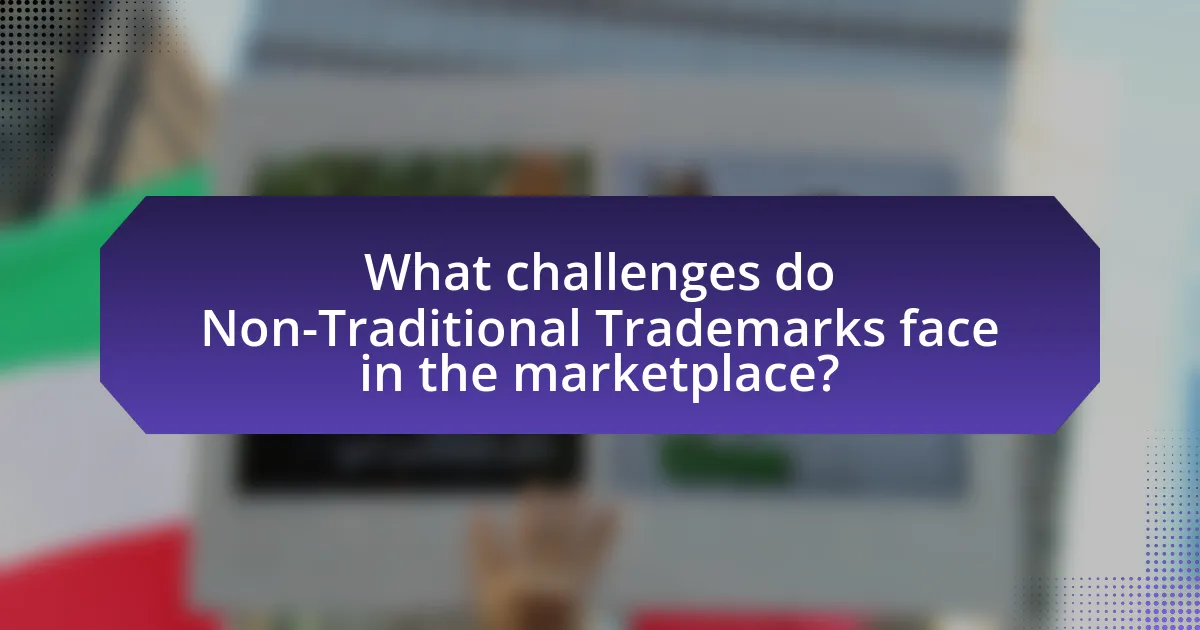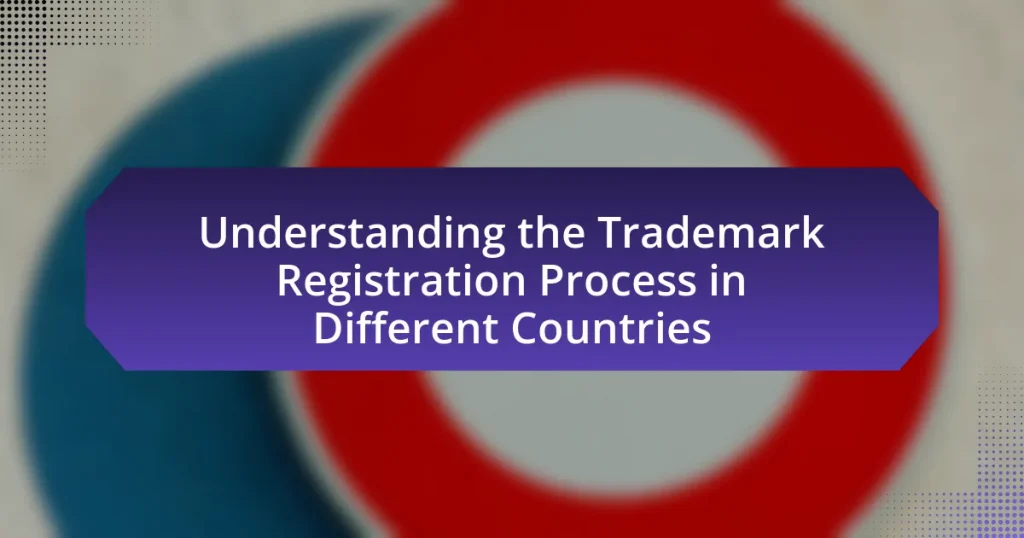Non-traditional trademarks are distinctive identifiers that extend beyond conventional trademarks, encompassing shapes, colors, sounds, scents, and textures. This article explores the significance of non-traditional trademarks in modern branding, highlighting their role in enhancing brand recognition, differentiation, and consumer loyalty. It discusses the various types of non-traditional trademarks, the legal challenges they face, and their psychological impact on consumer perception and behavior. Additionally, the article outlines best practices for businesses to effectively implement and protect these trademarks in a competitive marketplace, emphasizing the importance of cultural context in global branding strategies.

What are Non-Traditional Trademarks?
Non-traditional trademarks are distinctive signs that do not fall under the conventional categories of trademarks, such as words or logos. These include shapes, colors, sounds, scents, and even textures that can identify and distinguish goods or services in the marketplace. For example, the shape of a Coca-Cola bottle or the sound of the NBC chimes are recognized as non-traditional trademarks. The legal recognition of these trademarks varies by jurisdiction, but they play a significant role in modern branding by enhancing brand identity and consumer recognition.
How do Non-Traditional Trademarks differ from Traditional Trademarks?
Non-traditional trademarks differ from traditional trademarks primarily in their form and the types of identifiers they protect. Traditional trademarks typically consist of words, logos, or symbols that distinguish goods or services, while non-traditional trademarks encompass elements such as sounds, colors, shapes, scents, and even motions that can also serve to identify and distinguish a brand. For example, the sound of a specific jingle can be trademarked, as seen with NBC’s chimes, which are recognized as a non-traditional trademark. This distinction is significant because non-traditional trademarks often require more rigorous proof of distinctiveness and secondary meaning to be registered, as they may not inherently convey the source of goods or services without additional context.
What types of Non-Traditional Trademarks exist?
Non-traditional trademarks include types such as sound marks, color marks, shape marks, motion marks, and scent marks. Sound marks consist of distinctive sounds associated with a brand, like the NBC chimes. Color marks protect specific colors that signify a brand, such as Tiffany & Co.’s blue. Shape marks refer to the unique shape of a product or packaging, exemplified by the Coca-Cola bottle. Motion marks involve animated logos or sequences, while scent marks protect specific scents that identify a brand, although they are less common and more challenging to register. These categories demonstrate the evolving nature of trademark law in adapting to modern branding strategies.
Why are Non-Traditional Trademarks important in branding?
Non-traditional trademarks are important in branding because they enhance brand recognition and differentiation in a crowded marketplace. These trademarks, which include shapes, colors, sounds, and scents, allow companies to create unique identities that resonate with consumers on emotional and sensory levels. For instance, the distinct sound of a brand’s jingle can evoke specific associations and loyalty, as seen with the Intel chime, which has become synonymous with the brand. This sensory engagement not only helps in establishing a memorable brand presence but also aids in protecting intellectual property, as non-traditional trademarks can be legally recognized and enforced, thereby preventing imitation by competitors.
What role do Non-Traditional Trademarks play in consumer perception?
Non-traditional trademarks significantly influence consumer perception by enhancing brand recognition and differentiation. These trademarks, which include shapes, colors, sounds, and scents, create unique associations in the minds of consumers, allowing brands to stand out in competitive markets. For instance, the distinct sound of a brand’s jingle can evoke specific emotions and memories, reinforcing brand loyalty. Research indicates that consumers are more likely to remember and prefer brands that utilize non-traditional trademarks, as these elements engage multiple senses and create a more immersive brand experience. This sensory engagement can lead to stronger emotional connections, ultimately affecting purchasing decisions and brand loyalty.
How do Non-Traditional Trademarks influence brand loyalty?
Non-traditional trademarks, such as sounds, colors, and shapes, significantly influence brand loyalty by creating unique associations that enhance consumer recognition and emotional connection. These trademarks differentiate brands in a crowded marketplace, making them more memorable and fostering a sense of familiarity among consumers. For instance, the distinct sound of a jingle or a specific color scheme can evoke positive feelings and reinforce brand identity, leading to repeat purchases. Research indicates that brands utilizing non-traditional trademarks can achieve higher customer retention rates, as these elements contribute to a stronger brand image and consumer trust.
What psychological effects do Non-Traditional Trademarks have on consumers?
Non-traditional trademarks, such as sounds, colors, and shapes, significantly influence consumer perception and behavior. These trademarks evoke emotional responses and create strong brand associations, enhancing brand recall and loyalty. For instance, research indicates that colors can trigger specific emotions; the color red is often associated with excitement and urgency, which can drive consumer action. Additionally, unique sounds, like the Intel jingle, can create a memorable auditory brand identity, reinforcing consumer recognition. Such psychological effects lead to increased brand differentiation and can influence purchasing decisions, as consumers often prefer brands that resonate emotionally with them.

How are Non-Traditional Trademarks utilized in Modern Branding Strategies?
Non-traditional trademarks are utilized in modern branding strategies to create distinctive brand identities that go beyond conventional logos and names. These trademarks include sounds, colors, shapes, scents, and even motions, which help brands stand out in a crowded marketplace. For instance, the use of a specific color, like Tiffany Blue, is recognized as a trademark that conveys luxury and exclusivity, enhancing brand recognition and consumer loyalty. Research indicates that brands employing non-traditional trademarks can achieve a 20% increase in consumer recall compared to those using traditional marks alone. This demonstrates the effectiveness of non-traditional trademarks in enhancing brand differentiation and emotional connection with consumers.
What are the benefits of incorporating Non-Traditional Trademarks into branding?
Incorporating Non-Traditional Trademarks into branding enhances brand recognition and differentiation. These trademarks, which include shapes, colors, sounds, and scents, allow businesses to create a unique identity that stands out in a crowded marketplace. For instance, the distinct sound of a brand jingle can evoke strong emotional responses and foster customer loyalty, as seen with the Intel jingle, which has become synonymous with the brand. Furthermore, research indicates that brands utilizing Non-Traditional Trademarks can achieve a competitive advantage by appealing to consumers’ sensory experiences, thereby increasing brand recall and preference. This strategic use of diverse trademark types not only broadens the scope of brand expression but also strengthens the overall brand equity.
How do Non-Traditional Trademarks enhance brand differentiation?
Non-traditional trademarks enhance brand differentiation by utilizing unique identifiers such as shapes, colors, sounds, and scents that distinguish a brand from its competitors. These elements create a distinctive brand identity that resonates with consumers on an emotional level, making the brand more memorable. For instance, the use of a specific color in packaging can evoke certain feelings or associations, as seen with Tiffany & Co.’s signature blue box, which is instantly recognizable and associated with luxury. Additionally, non-traditional trademarks can protect innovative branding strategies, allowing companies to maintain a competitive edge in crowded markets. This differentiation is crucial in a global marketplace where consumers are inundated with choices, as it helps brands stand out and fosters customer loyalty.
What impact do Non-Traditional Trademarks have on market positioning?
Non-Traditional Trademarks significantly enhance market positioning by differentiating brands through unique identifiers such as shapes, colors, sounds, and scents. These trademarks create a distinct brand identity that can lead to increased consumer recognition and loyalty. For instance, the use of a specific color in branding, like Tiffany & Co.’s robin egg blue, has become synonymous with the brand, allowing it to stand out in a crowded market. Research indicates that brands utilizing non-traditional trademarks can achieve a competitive advantage, as they evoke emotional responses and foster stronger connections with consumers, ultimately influencing purchasing decisions.
How can businesses effectively implement Non-Traditional Trademarks?
Businesses can effectively implement Non-Traditional Trademarks by conducting thorough research to identify unique elements that can serve as trademarks, such as sounds, colors, or shapes. This process involves ensuring that these elements are distinctive and capable of indicating the source of goods or services. For instance, the color purple is famously associated with the brand T-Mobile, demonstrating how a specific color can function as a trademark when it is consistently used in branding and marketing. Additionally, businesses should engage in comprehensive trademark searches to avoid conflicts with existing trademarks and file for registration with the appropriate authorities to secure legal protection. This proactive approach not only safeguards the unique elements but also enhances brand recognition and consumer loyalty.
What steps should businesses take to register Non-Traditional Trademarks?
Businesses should take the following steps to register Non-Traditional Trademarks: first, they must identify the type of non-traditional trademark they wish to register, such as sounds, colors, or shapes. Next, they should conduct a comprehensive trademark search to ensure that the desired trademark is not already in use or registered by another entity. After confirming the uniqueness of the trademark, businesses need to prepare and file an application with the relevant trademark office, providing detailed descriptions and evidence of the trademark’s distinctiveness. Additionally, they should respond to any office actions or requests for additional information from the trademark office during the examination process. Finally, once the trademark is approved, businesses should monitor its use and enforce their rights to maintain the trademark’s validity. These steps are essential as they align with the legal requirements set forth by trademark offices, ensuring proper protection of the non-traditional trademark.
How can businesses protect their Non-Traditional Trademarks from infringement?
Businesses can protect their Non-Traditional Trademarks from infringement by registering them with the appropriate trademark office and actively monitoring their use in the marketplace. Registration provides legal recognition and exclusive rights, making it easier to enforce against unauthorized use. Additionally, businesses should conduct regular searches to identify potential infringements and take swift legal action when necessary. According to the United States Patent and Trademark Office, registered trademarks are presumed to be valid, which strengthens a business’s position in disputes. Furthermore, educating consumers about the brand and its unique identifiers can help in establishing distinctiveness, which is crucial for non-traditional trademarks like sounds, colors, or scents.

What challenges do Non-Traditional Trademarks face in the marketplace?
Non-traditional trademarks face significant challenges in the marketplace, primarily due to their inherent distinctiveness and the complexities of legal recognition. These trademarks, which include shapes, colors, sounds, and scents, often struggle to meet the requirements for trademark protection, as they must demonstrate acquired distinctiveness or secondary meaning to be recognized by consumers. For instance, a color trademark must show that consumers associate that color specifically with a brand, which can be difficult to prove. Additionally, non-traditional trademarks may encounter difficulties in enforcement, as their unique nature can lead to ambiguity in infringement cases, making it harder for owners to defend their rights. This complexity is compounded by varying international standards for trademark registration and protection, which can create inconsistencies in how these trademarks are treated across different jurisdictions.
What legal issues are associated with Non-Traditional Trademarks?
Legal issues associated with non-traditional trademarks include challenges in proving distinctiveness, potential for dilution, and difficulties in enforcement. Non-traditional trademarks, such as sounds, scents, and colors, often face scrutiny regarding their ability to identify the source of goods or services, which is a requirement for trademark protection. For instance, the U.S. Patent and Trademark Office (USPTO) requires that non-traditional trademarks demonstrate acquired distinctiveness through extensive use in commerce, which can be difficult to establish. Additionally, non-traditional trademarks may be more susceptible to dilution claims, as their unique characteristics can lead to confusion with similar marks. Enforcement can also be problematic, as the subjective nature of non-traditional trademarks complicates the determination of infringement, making it harder for owners to protect their rights effectively.
How do courts interpret Non-Traditional Trademarks in disputes?
Courts interpret non-traditional trademarks by assessing their distinctiveness and the likelihood of confusion among consumers. In disputes, judges evaluate whether the non-traditional mark, such as sounds, colors, or scents, serves to identify the source of goods or services. For instance, the U.S. Supreme Court in the case of Qualitex Co. v. Jacobson Products Co. established that a color can be trademarked if it has acquired distinctiveness and does not serve a functional purpose. Courts often rely on the “secondary meaning” standard, which requires evidence that consumers associate the mark with a specific source. This interpretation is crucial in determining the validity and enforceability of non-traditional trademarks in legal conflicts.
What are common misconceptions about Non-Traditional Trademarks?
Common misconceptions about non-traditional trademarks include the belief that they are not legally protectable and that they are only applicable to logos or words. In reality, non-traditional trademarks, such as sounds, colors, and shapes, can be registered and protected under trademark law, provided they meet the distinctiveness requirement. For instance, the color pink for insulation, as used by Owens-Corning, is a recognized non-traditional trademark, demonstrating that unique identifiers beyond traditional marks can receive legal protection. Additionally, many assume that non-traditional trademarks are less valuable than traditional ones; however, they can significantly enhance brand identity and consumer recognition, as seen with the distinctive sound of the NBC chimes.
How do cultural differences affect the perception of Non-Traditional Trademarks?
Cultural differences significantly influence the perception of Non-Traditional Trademarks, as these trademarks often rely on cultural symbols, colors, and meanings that vary across societies. For instance, a color that signifies luxury in one culture may represent mourning in another, affecting brand recognition and consumer response. Research indicates that cultural context shapes how consumers interpret logos, sounds, and scents associated with brands, leading to varying degrees of effectiveness in marketing strategies. A study by Zhang and Schmitt (2001) published in the Journal of Consumer Research highlights that consumers from collectivist cultures may respond more positively to Non-Traditional Trademarks that emphasize community and harmony, while those from individualistic cultures may prefer trademarks that convey uniqueness and personal identity. This demonstrates that understanding cultural nuances is essential for brands utilizing Non-Traditional Trademarks to ensure they resonate appropriately with target audiences.
What role does cultural context play in trademark recognition?
Cultural context significantly influences trademark recognition by shaping consumer perceptions and associations with brands. For instance, symbols, colors, and phrases may carry different meanings across cultures, affecting how trademarks are interpreted. A study by the World Intellectual Property Organization (WIPO) highlights that trademarks that resonate with local cultural values are more likely to be recognized and trusted by consumers. This indicates that understanding cultural nuances is essential for effective branding and trademark strategy in diverse markets.
How can brands adapt Non-Traditional Trademarks for global markets?
Brands can adapt Non-Traditional Trademarks for global markets by conducting thorough market research to understand cultural nuances and legal frameworks in different regions. This approach allows brands to tailor their trademarks, such as sounds, colors, or shapes, to resonate with local consumers while ensuring compliance with local trademark laws. For instance, the color red is associated with good fortune in China, which can influence branding strategies in that market. Additionally, brands should engage with local legal experts to navigate the complexities of trademark registration and protection, as seen in the case of the sound trademark registered by NBC, which highlights the importance of legal adaptation in various jurisdictions.
What best practices should brands follow when using Non-Traditional Trademarks?
Brands should ensure distinctiveness and non-functionality when using Non-Traditional Trademarks. Distinctiveness is crucial as it allows the trademark to be recognized and associated with the brand, which is supported by the legal requirement that trademarks must identify the source of goods or services. Non-functionality is essential because functional features cannot be trademarked; for instance, the shape of a bottle that serves a practical purpose cannot be protected as a trademark. Additionally, brands should conduct thorough searches to avoid conflicts with existing trademarks, as evidenced by the increased litigation in cases involving non-traditional marks. Finally, brands should consistently use and enforce their trademarks to maintain their rights, as failure to do so can lead to loss of protection.



